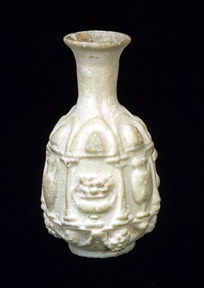
Syria, late Seleucid-early Roman period
Circa 1st century BCE - 1st century CE
Mold-blown glass
H: 7.6 cm
Eugene Fuller Memorial Collection
#57.141
Image courtesy of the Seattle Art Museum (copyright reserved)
Sometime in the century before the Common Era, an important technological advance was made in the art of glass working. This was the blowpipe, a tool that allowed a number of innovations by allowing the glassmaker to inflate and expand the glass to easily form symmetrical, spheroid shapes. It also permitted the creation of an entirely new technique: mold-blowing.
It is believed that mold-blowing technique was first developed in Jerusalem in the mid-1st century BCE, and quickly spread to other parts of the Near East. To create vessels such as this one from the Seattle Art Museum, a gather of molten glass was blown into a mold composed of two or three parts and carved into the desired pattern. Syria glass blowers first became famous for their technique at the very end of the Seleucid era. By the late 1st century BCE this technique was the major method of glass production in Syria, and mold-blown glass became an important export item under the Romans.